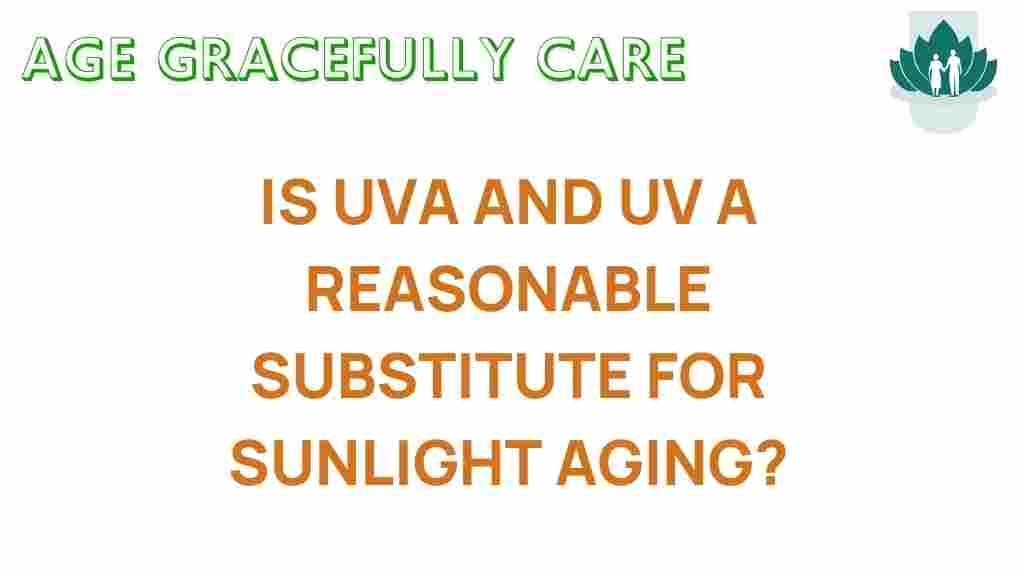Can UVA and UVB Really Replace Sunlight in the Fight Against Aging?
In the quest for youthful skin, the debate surrounding UVA and UVB rays versus natural sunlight has gained significant traction. Many skincare enthusiasts and dermatologists are exploring whether these forms of UV exposure can provide the same health benefits as sunlight in combating skin aging. This article delves into the intricate relationship between UVA, UVB, sunlight, and skin aging, aiming to shed light on effective skincare strategies in the realm of anti-aging.
Understanding UVA and UVB Rays
UV radiation from the sun is divided into two main types: UVA and UVB. Each plays a distinct role in how our skin ages and reacts to sun exposure.
- UVA Rays: These rays penetrate deep into the skin and are primarily responsible for photoaging. They can lead to collagen breakdown, loss of elasticity, and formation of wrinkles.
- UVB Rays: These rays are responsible for causing sunburn and play a significant role in the development of skin cancer. UVB rays affect the outer layer of the skin and are crucial in vitamin D synthesis.
Both types of rays can have detrimental effects on skin health, making it essential to understand their roles in skin aging.
Can Artificial UV Sources Mimic Sunlight?
When discussing whether UVA and UVB can replace sunlight in skincare, it is crucial to consider the various sources of UV radiation. Many people are turning to tanning beds and other artificial UV sources as a means to achieve a sun-kissed glow. However, these methods come with risks.
- Indoor Tanning: Tanning beds primarily emit UVA rays, which can accelerate skin aging and increase the risk of skin cancer.
- Sunscreens and UV Filters: While they protect against harmful UV exposure, some sunscreens are formulated to mimic the benefits of UV rays without the associated risks.
It’s important to note that while artificial UV exposure may offer some benefits, it cannot fully replace the complex benefits of natural sunlight.
The Role of Sunlight in Skin Health
Natural sunlight offers several health benefits that UVA and UVB rays alone cannot replicate:
- Vitamin D Synthesis: Sunlight is essential for the body to produce vitamin D, which plays a vital role in skin health and immune function.
- Improved Mood: Exposure to sunlight can enhance mood and reduce symptoms of depression, promoting overall skin health indirectly.
- Natural Glow: Sunlight provides a natural glow that cannot be achieved through artificial sources.
Understanding Skin Aging
Skin aging is a multifaceted process influenced by various factors, including genetics, lifestyle, and environmental exposure. UVA and UVB rays contribute significantly to skin aging through:
- Photoaging: Prolonged exposure to UV radiation can lead to wrinkles, fine lines, and pigmentation.
- Oxidative Stress: UV exposure generates free radicals, leading to skin damage and premature aging.
Incorporating effective skincare routines can help mitigate the effects of UV exposure on skin aging.
Skincare Strategies for Anti-Aging
To combat skin aging while enjoying the benefits of sunlight, consider implementing the following skincare strategies:
- Use Sunscreen: Apply broad-spectrum sunscreen with at least SPF 30 daily, regardless of the weather. This protects against both UVA and UVB rays.
- Antioxidant Serums: Incorporate products rich in antioxidants, such as vitamin C, to combat oxidative stress from UV exposure.
- Hydration: Keep your skin moisturized to maintain elasticity and combat dryness caused by sun exposure.
- Regular Exfoliation: Exfoliate regularly to remove dead skin cells and promote cell turnover, helping to rejuvenate the skin.
These strategies can significantly enhance your skincare regimen and provide protection against skin aging.
Step-by-Step Anti-Aging Skincare Routine
To maximize the effectiveness of your skincare routine against aging, follow this step-by-step guide:
- Cleanse: Use a gentle cleanser to remove dirt and impurities without stripping your skin’s natural oils.
- Apply Toner: Use a toner to balance your skin’s pH and prepare it for the following products.
- Serum Application: Apply an antioxidant serum to protect against free radicals.
- Moisturize: Use a hydrating moisturizer to lock in moisture and maintain skin elasticity.
- Sunscreen: Finish with broad-spectrum sunscreen to protect your skin from harmful UVA and UVB rays.
This routine can help safeguard your skin from the effects of UV exposure and promote a youthful appearance.
Troubleshooting Common Skin Issues
Even with the best skincare routine, you may encounter some common skin issues. Here’s how to troubleshoot:
- Dry Skin: If your skin feels tight or flaky, consider using a richer moisturizer or adding a hydrating serum to your routine.
- Sunburn: If you experience sunburn, apply aloe vera gel or a soothing lotion to calm the skin and promote healing.
- Hyperpigmentation: Use products containing ingredients like hydroquinone or vitamin C to brighten dark spots.
By addressing these common issues, you can maintain healthier skin while minimizing the signs of aging.
The Bottom Line
While UVA and UVB rays play a significant role in skin aging, they cannot fully replace the multifaceted benefits of natural sunlight. Sunlight contributes to vitamin D synthesis, mood enhancement, and an overall healthy glow. However, responsible UV exposure is essential.
To combat skin aging effectively, integrate a comprehensive skincare routine that includes sun protection, antioxidants, and hydration. Always consult a dermatologist to tailor your skincare regimen to your specific needs. For more insights on skincare and dermatology, check out this resource on skin health.
In conclusion, while UVA and UVB can contribute to our understanding of skin health, the irreplaceable benefits of sunlight remind us to embrace a balanced approach to skincare. Remember, moderation is key—enjoy the sun responsibly!
This article is in the category Health and created by AgeGracefullyCare Team
